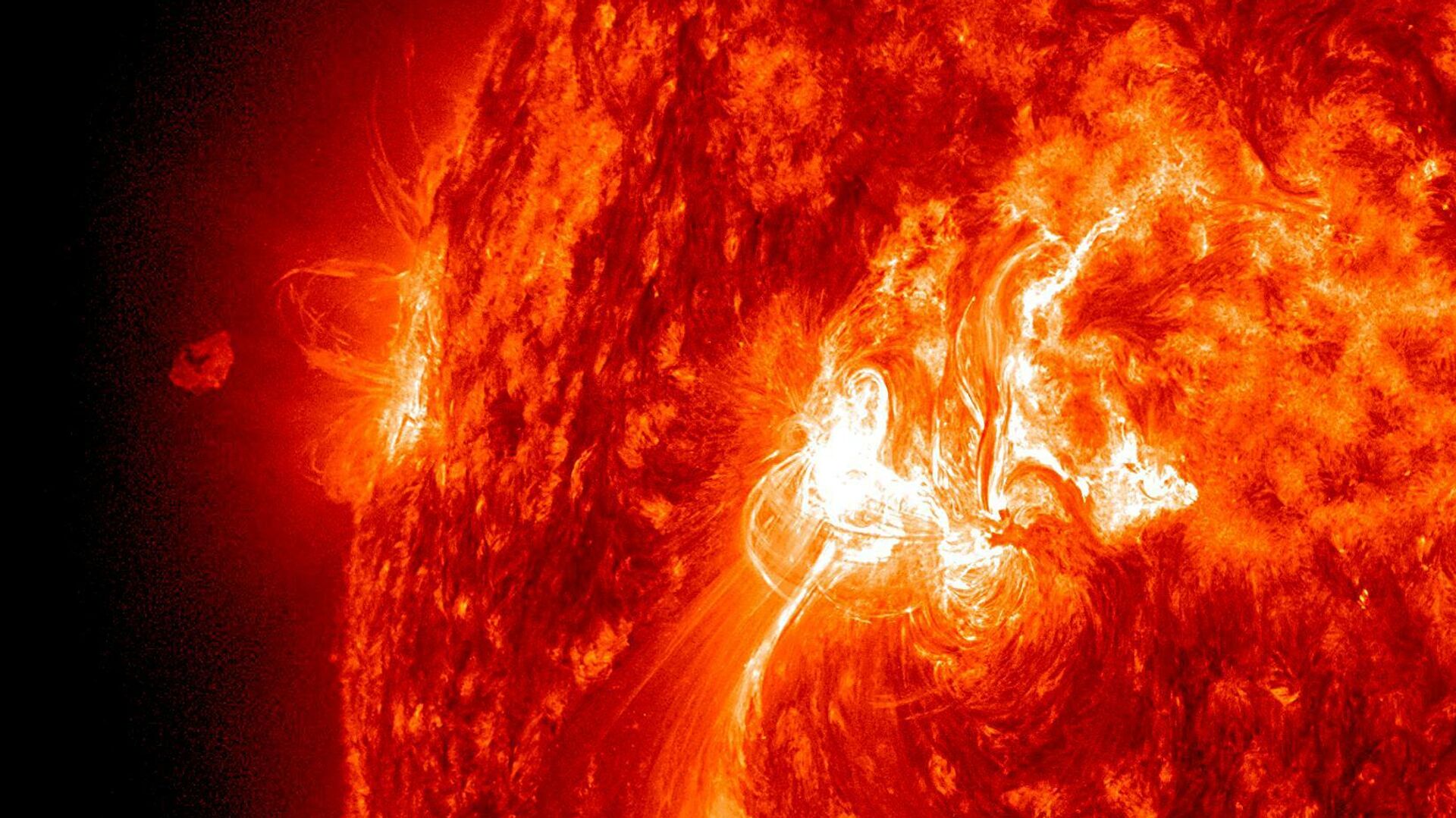https://sputnikglobe.com/20220325/the-suns-atmosphere-is-hotter-than-its-surface-now-we-know-why-1094201547.html
The Sun’s Atmosphere is Hotter than Its Surface, Now We Know Why
The Sun’s Atmosphere is Hotter than Its Surface, Now We Know Why
Sputnik International
Normally, when you move away from a source, heat dissipates and the surrounding temperature drops. Consider a space heater and how less effective it is across... 25.03.2022, Sputnik International
2022-03-25T19:22+0000
2022-03-25T19:22+0000
2023-04-12T16:57+0000
sun
temperature
science & tech
space
https://cdn1.img.sputnikglobe.com/img/07e6/01/1d/1092597281_0:26:1650:954_1920x0_80_0_0_be1929e6807dbd6addc19a276253d7ef.jpg
Scientists from the University of Otago have unified two current theories to explain why the sun’s atmosphere is so much hotter than its surface.The sun’s heat is generated at its core, which is believed to be over 27 million degrees C. By the time that energy reaches the surface, it has cooled to a relatively low 6000 degrees C. Then, in the sun’s atmosphere, or corona, the temperature heats back up to over a million degrees in just a few hundred kilometers.Scientists have had trouble explaining why. There were two prevailing theories, but both had issues. One theory held that turbulence from the sun’s energy caused gasses in its atmosphere, mostly hydrogen, helium and oxygen, to heat up. But that didn’t explain why electrons near the sun stayed relatively cool.That could be explained by the other theory, magnetic waves. That theory holds that the sun’s magnetic field, far more chaotic than earth’s, will smash into itself, causing a massive amount of energy dissipation. That would heat up the gas without affecting the electrons. But scientists have not observed enough magnetic activity on the sun to account for the entirety of the corona’s incredible heat.A new theory, co-published by Dr. Jonathan Squire and Dr. Romain Meyrand in Nature Astronomy, used a six-dimensional computer simulation and determined that both theories were correct. They work together to both heat the gasses while keeping electrons relatively cool.What connects these two previously incompatible theories has been called the “helicity barrier” by Squire. It causes the turbulence factor to only heat up the smallest scale particles, i.e. ions, not electrons. This heats up the gas while diverting energy in the electrons into ion cyclotron waves.Their findings also match what was observed by NASA’s Parker Solar Probe spacecraft, the first manmade object to fly into the sun's corona.The heat from the corona causes the gasses to burst out and fly through our solar system, commonly known as solar wind. Solar wind and its concomitant radiation can wreak havoc on satellites, the energy grid and earth’s magnetic field.Understanding the sun’s corona, besides giving us a better understanding of our solar system, could help us predict solar wind and create prevention strategies that could save telecommunication economies from billions of dollars in damage, according to Squire.
Sputnik International
feedback@sputniknews.com
+74956456601
MIA „Rossiya Segodnya“
2022
Sputnik International
feedback@sputniknews.com
+74956456601
MIA „Rossiya Segodnya“
News
en_EN
Sputnik International
feedback@sputniknews.com
+74956456601
MIA „Rossiya Segodnya“
Sputnik International
feedback@sputniknews.com
+74956456601
MIA „Rossiya Segodnya“
sun, temperature, science & tech, space
sun, temperature, science & tech, space
The Sun’s Atmosphere is Hotter than Its Surface, Now We Know Why
19:22 GMT 25.03.2022 (Updated: 16:57 GMT 12.04.2023) Normally, when you move away from a source, heat dissipates and the surrounding temperature drops. Consider a space heater and how less effective it is across the room as opposed to when it's right next to you. That is not the case with the sun.
Scientists from the University of Otago have unified two current theories to explain why the sun’s atmosphere is so much hotter than its surface.
The sun’s heat is generated at its core, which is believed to be over 27 million degrees C. By the time that energy reaches the surface, it has cooled to a relatively low 6000 degrees C. Then, in the sun’s atmosphere, or corona, the temperature
heats back up to over a million degrees in just a few hundred kilometers.
Scientists have had trouble explaining why. There were two prevailing theories, but both had issues. One theory held that turbulence from the sun’s energy caused gasses in its atmosphere, mostly hydrogen, helium and oxygen, to heat up. But that didn’t explain why electrons near the sun stayed relatively cool.
That could be explained by the other theory, magnetic waves. That theory holds that the sun’s magnetic field, far more chaotic than earth’s, will smash into itself, causing a massive amount of energy dissipation. That would heat up the gas without affecting the electrons. But scientists have not observed enough magnetic activity on the sun to account for the entirety of the corona’s incredible heat.
A new theory, co-published by Dr. Jonathan Squire and Dr. Romain Meyrand in Nature Astronomy, used a six-dimensional computer simulation and determined that
both theories were correct. They work together to both heat the gasses while keeping electrons relatively cool.
What connects these two previously incompatible theories has been called the “helicity barrier” by Squire. It causes the turbulence factor to only heat up the smallest scale particles, i.e. ions, not electrons. This heats up the gas while diverting energy in the electrons into ion cyclotron waves.
"If we imagine plasma heating as occurring a bit like water flowing down a hill, with electrons heated right at the bottom, then the helicity barrier acts like a dam, stopping the flow and diverting its energy into ion cyclotron waves. In this way, the helicity barrier links the two theories and resolves each of their individual problems," explained Myrand
Their findings also match what was observed by NASA’s Parker Solar Probe spacecraft, the first manmade object to fly into the sun's corona.
The heat from the corona causes the gasses to burst out and fly through our solar system, commonly known as solar wind. Solar wind and its concomitant radiation can wreak havoc on satellites, the energy grid and earth’s magnetic field.
Understanding the sun’s corona, besides giving us a better understanding of our solar system, could help us predict solar wind and create prevention strategies that could save telecommunication economies from billions of dollars in damage, according to Squire.

